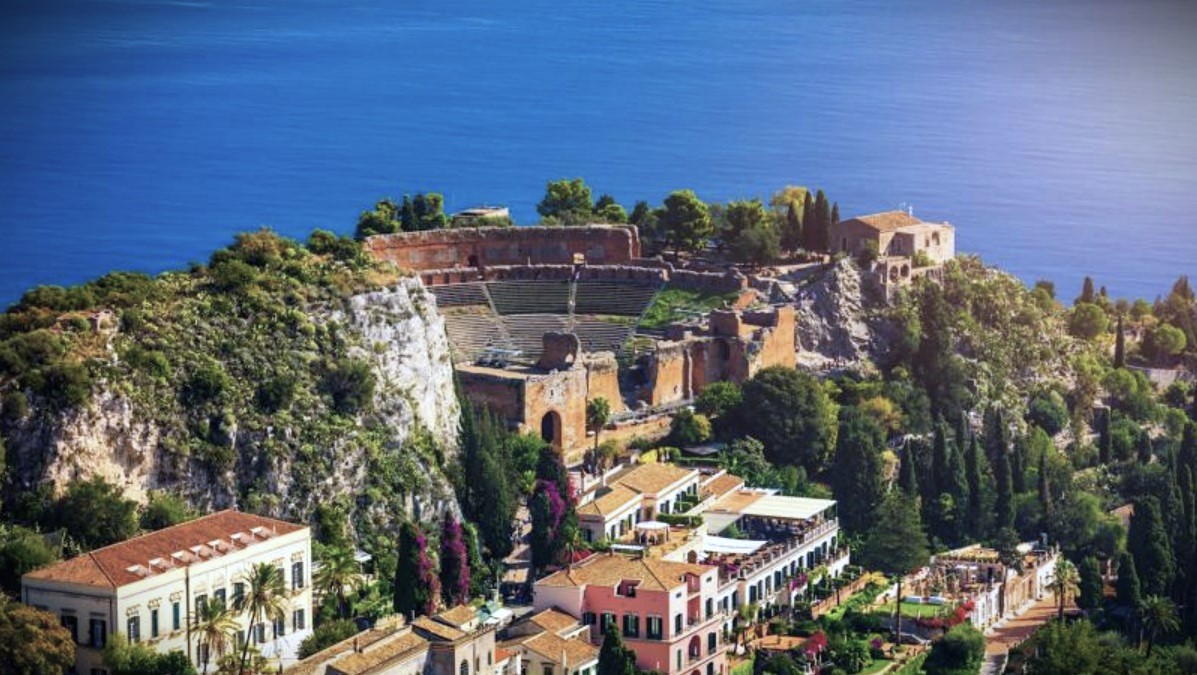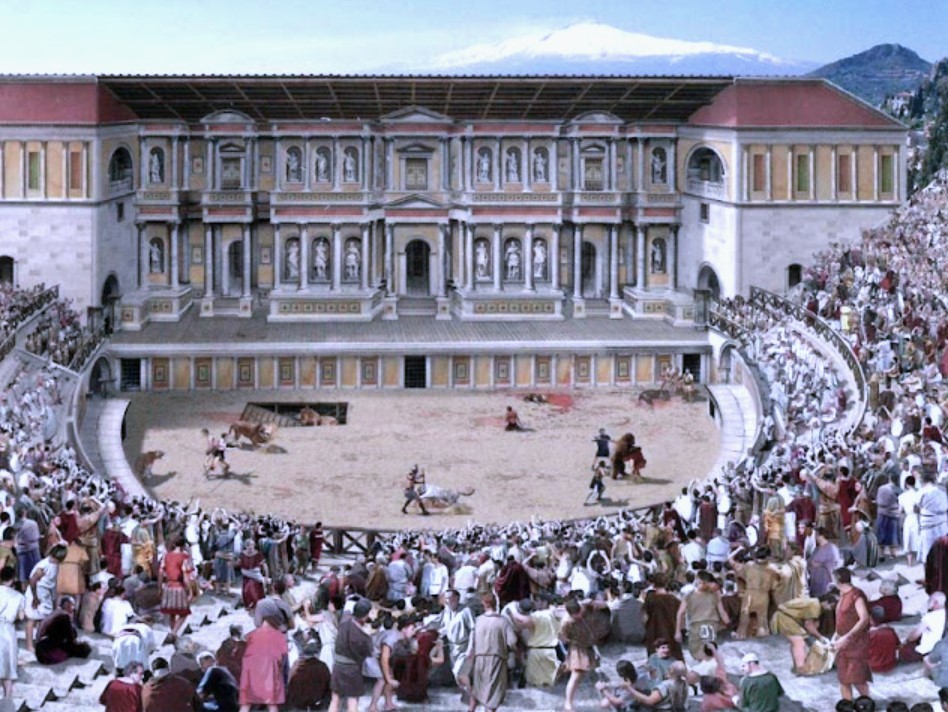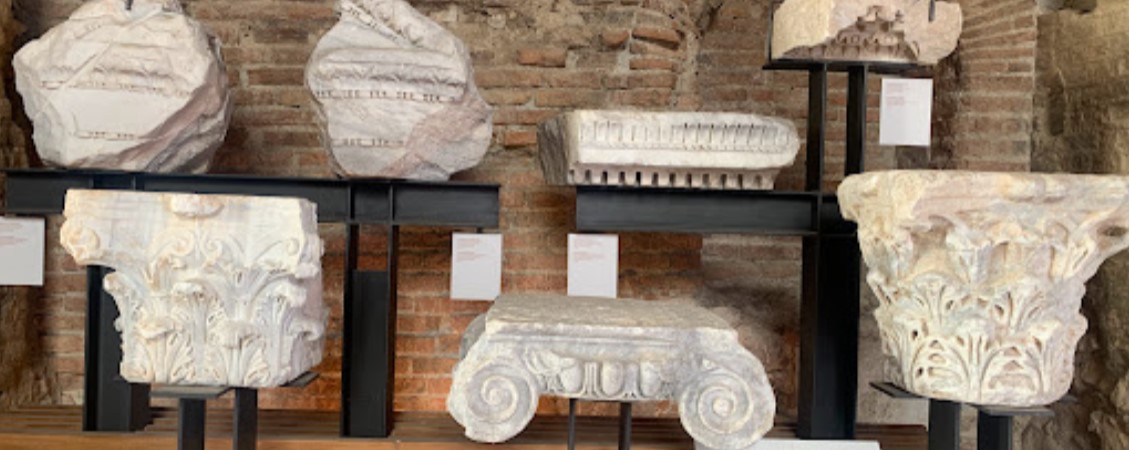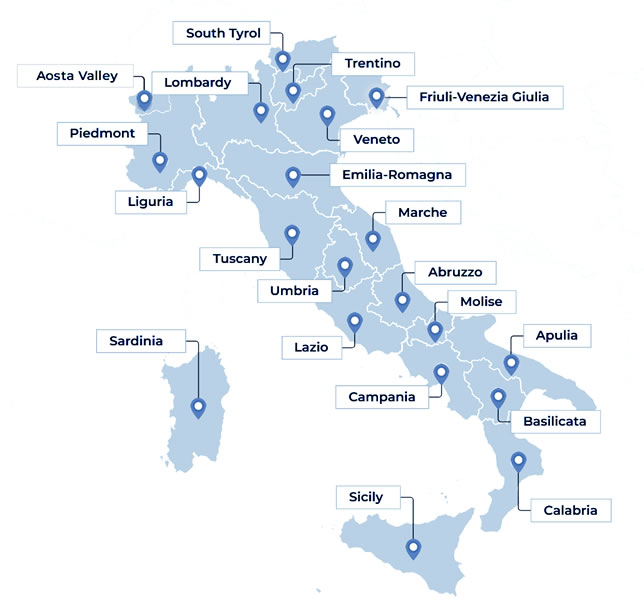

Explore Italy by place | region | time period
Republican Rome » Taormina (Messina, Sicily)
According to the account of the Greek historian Ephorus (c. 400–330 BCE), as conveyed by the geographer Strabo (c. 60 BCE - c. 21 CE), the inhabitants of Sicily managed to prevent the ancient Greeks and Etruscan pirates, who frequented the waters around the strait in the 8th century BCE, from settling in their lands. A storm shipwrecked the Athenian Theokles on the eastern shores of Sicily; he fell in love with the beauty of the place, and the few locals allowed him to return with a colony of Chalcidians. After him, other colonists arrived, and the island became entirely Greek in language and customs..
The legend recounts that after many years and vicissitudes, in 358 BCE, Andromachus, the father of the historian Timaeus, gathered the survivors of Naxos and their descendants and led them to that hill shaped like a bull (Tauros) about 200 meters above sea level, which then took the name Tauromenion. It later passed into the hands of Agathocles, then the Carthaginians (315 BCE), and later the tyrant Tyndarion, who facilitated the landing of Pyrrhus on this part of the island. Subsequently, it became part of the kingdom of Hiero II and only after his death did it fall into Roman hands.
Perhaps Tauromènion received favorable treatment from the Romans due to its importance: it was listed among the very few civitates foederatae , and Octavian transformed it into a military colony for its significant strategic position in 34 BCE.
After the fall of the Western Roman Empire (5th century CE), the southern coasts of Sicily began to experience raids by Arabs, who incited holy war against the infidel Christians. Their raids continued in the 7th, 8th, and 9th centuries. Destroyed and then rebuilt by the Arabs, the city was finally occupied by the Normans in 1079.
Over time, the name of the ancient Greek city Tauromenion (in Latin Tauromenium) transformed into Taormina, meaning habitation on the Tauro, the mountain on which it arose.

Taormina is one of the most beautiful places in Italy. It is among the most typical and unique Sicilian cities to visit.
Situated on a high but sloping plateau of mountains that rise above the sea, it offers views of the Gulf of Schisò and the imposing Etna, the largest active volcano in Europe.
As described by the German writer and diplomat Carl August Schneegans (1835–1898) in his book Memoiren, Ein Beitrag zur Geschichte des Elsasses in der Übergangszeit about his journey to Sicily:
Taormina is the sad remnant of a great and powerful city, which dominated land and sea for centuries; it is a crouched colossus. Here, the breath of Greek and medieval times, of classical and romantic life, European and African, still lingers and gives the place a picturesque color ... even if I had Goethe's pen and Raphael's brush, I could not describe or paint this city.
The aspect that presents itself among these narrow streets is marvelous, for each century has left a trace of itself in those stones: the Christian Middle Ages in the Gothic arches of those bell towers; the Orient in those richly decorated pillars; the Normans in the massive, square castles; Rome and the Iliad in the wide circuit of that theater, in the beautiful Corinthian capitals, in the tall columns, and in the white marble walls that still greet us everywhere. And what a sight awaits the traveler, seated on the highest steps of the semicircle, as his eye ranges beyond the theater and the wide arches, over the silver sea, the rocks of Taormina, the hills and mountains up to the eternally snow-covered Etna, which rises with a sweet and harmonious slope into the clear air, crowned with smoke, immense, menacing, and completes the perspective in a classically serene manner!

The ruins of ancient buildings, foremost among them the magnificent theater, inscriptions, and coins speak of Taormina's remarkable flourishing during the Hellenistic and Roman periods. In antiquity, sailors could admire from the sea the Greek city perched on the mountain, with its acropolis, agora, sanctuaries, and fortifications. By the early 1800s, little remained of the ancient city, just parts of the walls, temple foundations, and the grand Greek theater. The best-preserved monuments were medieval, like the Tower of the Badia Vecchia, the Duomo, Palazzo Santo Stefano, and the crenellated Palazzo Corvaia, next to the sixteenth-century church of Santa Caterina.
The small, quiet medieval city had a much more modest life than the ancient one and offers, along with its famous panoramas, a distinctive character. Nothing remains of the early Middle Ages. The surviving monuments present a special type between the Aragonese period's flourishing Gothic and the Sicilian Renaissance—if it can be so called—also medieval in its structure, where the traditional Norman technique survives, including the use of white limestone paired with lava pumice as an ornamental inlay that makes the buildings' appearance distinctive and unmistakable.

Starting from the second half of the eighteenth century, the Grand Tour gained traction in Europe: a long educational journey through Italian art and architecture that also crossed Sicily. Among the most illustrious participants was the writer and poet Johann Wolfgang von Goethe (1749-1832), who described the Taormina theater in 1787:
If one stands at the highest point occupied by the ancient spectators [of the ancient theater], one must admit that probably never before did a theater audience see anything similar. On the right side, castles overlook from the rocks; below us, the city stretches out, and despite its recent houses, they certainly occupy the same places where others stood in ancient times. In front of us, the entire long mountain massif of Etna; to the left, a coast of the sea up to Catania, even to Syracuse; and the vast panorama is closed by the colossal smoking volcano, which appears more distant and gentler in the sweetness of the sky, without inspiring terror.

The theater stands on Monte Croce, one of Tauromenion's acropolises. It represents a gem for both history and architecture. A marvel of aesthetics and musical harmony, it is one of the best-preserved theaters in the world. It is the largest in Sicily after the one in Syracuse.
Based on the few archaeological documents in possession, the Greek Theater of Taormina was erected in the Hellenistic period (3rd century BCE) during the rule of Hiero II, as evidenced by some Greek inscriptions very similar to contemporary ones in the Syracuse theater. On some steps, the name of Philistis, the wife of Hiero II, the tyrant of Syracuse who most likely had the Taormina theater built, is inscribed.

The theater is erroneously called Greek because its origin is undoubtedly Greek, but the surviving structures today are from the Roman era when the building was almost completely redone (2nd century CE). The transformations of the Roman era saw the amphitheater, once intended for theatrical performances, host the famous venationes identical to those at the Colosseum, where gladiators and wild beasts fought before an enraptured crowd. It was also used at the time as a modern theater, a place to stage tragedies or comedies (famous were those of Aeschylus, Sophocles, and Euripides): on these occasions, it was probably adorned with architectural embellishments, columns, statues, and coverings.

For example, of the Greek cavea, adapted into a natural cavity of the terrain, little remains; better preserved is the Greek stage, from whose terraces one can enjoy the splendid panorama that constitutes the monument's main attraction. Additionally, some elements of the ancient Greek theater remain, such as erratic stones already part of the seats, bearing Greek inscriptions.
The current monument in brick structure is typically Roman. Originally there was only a small central building, then it was almost completely rebuilt at the end of the 1st century CE and expanded in the first half of the 2nd century CE to reach a diameter of 109 meters, with an orchestra 35 meters in diameter.
It took 100,000 cubic meters of rock, manually removed, to construct it. The lower steps visible today were replaced with a scenic corridor, which served both for the entrance of fighters and as support for installing protections to safeguard the spectators. Underground corridors and walkways, still visible today, were used to move machines, fighters, and beasts. To close the stage background on Etna, there was a double colonnade adorned with statues, flanked by large rooms for actors, now semi-destroyed.

In essence, it combines Greek and Roman construction methods: the Greek manner of carving the cavea into the rock itself while the Romans built their theaters above ground; the Roman concept of the imposing and luxurious stage, and all the structures are Roman.
Abandoned after the Vandal siege, during the Middle Ages, the stage structure and the two stair towers were reused for the construction of a palace.
The theater experienced periods of splendor and abandonment: it remained unused after the fall of the Roman Empire and was revitalized only after its complete restoration in 1955.

The Greek word theatron (theater) contains the root of the verb theaomai, meaning "to look," "to contemplate." The theater is, therefore, the place from which one watches a show. Theatrical architecture also originates in Greece. Here, however, the building for performances does not have the monumental prominence that will become one of the main characteristics of the Roman theater a few centuries later.
The Greek theater, in fact, does not impose itself on the landscape; rather, it harmoniously integrates into it. It rises outside the city, in the most suitable place for creating the cavea—the space for spectators—which must have large dimensions and good acoustics. A hillside slope is chosen, provided with seating structures, and an area for the performance is created at its foot.
This harmonious integration of the building into the natural environment is a peculiarity of all known Greek theaters, always open to panoramas of great beauty. For example, from the summa cavea of the Taormina theater, there is a breathtaking view of the coast and Mount Etna.

The Taormina Greek theater comprises:
For years, the Taormina theater has been the splendid setting for cultural events and international awards.

In order to know more, you can visit:
- Wikipedia: [1]
This page was last update on 26 July 2024

Open in Google Maps and find out what to visit in a place.
Go to: Abruzzo | Aosta Valley | Apulia | Basilicata | Calabria | Campania | Emilia Romagna | Friuli Venezia Giulia | Lazio | Liguria | Lombardy | Marche | Molise | Piedmont | Sardinia | Sicily | South Tyrol | Trentino | Tuscany | Umbria | Veneto

Text and images are available under the Creative Commons Attribution-ShareAlike License 4.0; - italystudynotes.eu - Privacy